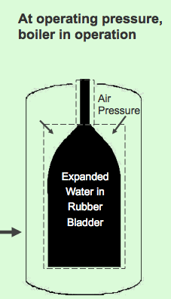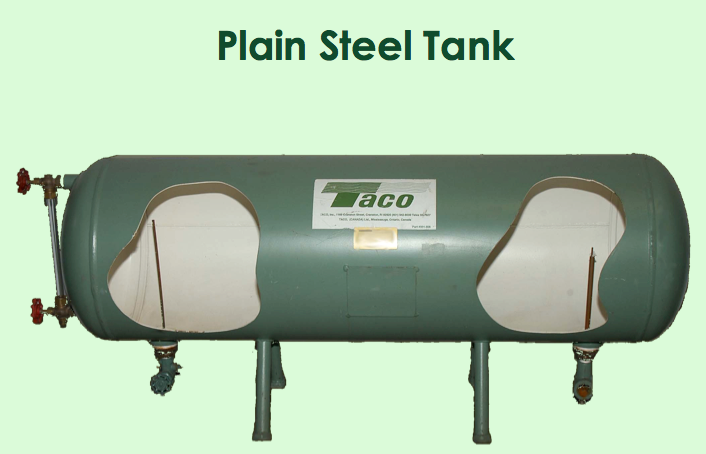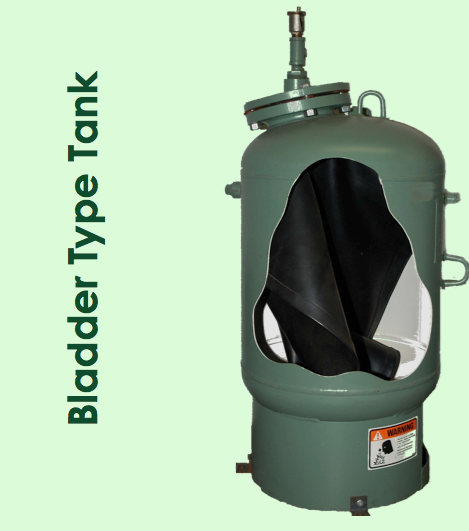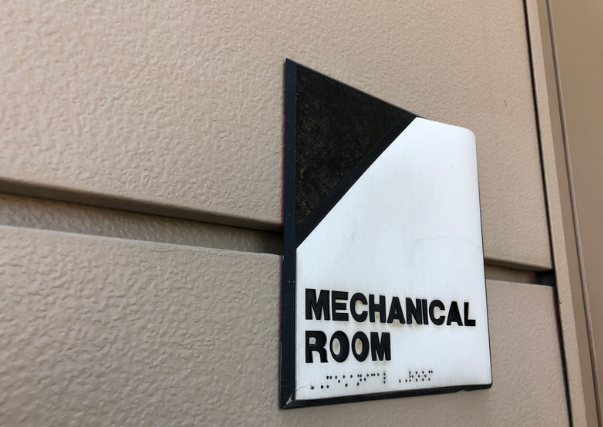Before we get into the common issues associated with plain steel expansion tanks and old Air Control Systems, let me first describe the expansion tank, which is an integral part of any Air Control or Air Elimination strategy.
An expansion tank is a pressure vessel designed to accept the additional fluid volume created as a result of heating the water in the system.
In other words, as water is heated, it expands. And, as water is virtually incompressible, that additional volume must be directed somewhere, else you will quickly find your safety valves relieving the excess pressures or you might discover the weakest point in your piping system!
 Most expansion tanks used today are bladder, or diaphragm, type. Essentially, they incorporate a rubber balloon that fills with the expanded volume and keep the water permanently separate from the air in the tank acting as a cushion.
Most expansion tanks used today are bladder, or diaphragm, type. Essentially, they incorporate a rubber balloon that fills with the expanded volume and keep the water permanently separate from the air in the tank acting as a cushion.
 Older style expansion tanks were commonly called “plain steel” and had no bladder – they were just an empty tank. They included an air fill valve, a drain valve, and often a gauge glass (or “sight glass”) in order to visually see the level of water on the inside. The idea was to charge the tank with enough air pressure so that, at ambient temperature, the tank volume was half air and half water, as indicated by the sight glass. It should also be installed at the highest point possible. During normal operation, expanded system water volume enters the tank, compressing the air; while the air separator would vent the air up to the tank to ensure that air cushion was always present.
Older style expansion tanks were commonly called “plain steel” and had no bladder – they were just an empty tank. They included an air fill valve, a drain valve, and often a gauge glass (or “sight glass”) in order to visually see the level of water on the inside. The idea was to charge the tank with enough air pressure so that, at ambient temperature, the tank volume was half air and half water, as indicated by the sight glass. It should also be installed at the highest point possible. During normal operation, expanded system water volume enters the tank, compressing the air; while the air separator would vent the air up to the tank to ensure that air cushion was always present.
 Four Reasons Owners and Design Engineers Have Moved Away from Plain Steel Expansion Tanks
Four Reasons Owners and Design Engineers Have Moved Away from Plain Steel Expansion Tanks
Although we still sell a few each year, most owners and design engineers have moved away from plain steel expansion tanks for the following reasons:
- Air elimination vs. air control: Air stays in direct contact with system water in a plain steel tank. Therefore, air can never be eliminated from the system. eliminated from the system.
- Leaks: The sight glass, or gauge glass assembly, is a weak point. Seals within the valves on these assemblies tend to dry out and contract, allowing the needed air cushion to escape. You may see pressure relief valves popping off in the system.
- Installation limitations: Plain steel tanks must be installed horizontally at the highest possible point in the system to ensure air bubbles flow UP into them. So, they are hung high in the ceiling – difficult to install and difficult to service. This is much less flexible than bladder or diaphragm tanks that may be installed vertically or horizontally, in the air or on the floor.
- The “out-of-sight” glass: In most existing installations, you cannot see the sight glass. It is either up high with the tank where it isn’t visible, or the glass has clouded internally. How do you know if the tank still has air if you can't see the gauge?
 There are likely other reason folks have moved away from plain steel tanks, but these four are the most common. So, if this is old technology, why write this blog?
There are likely other reason folks have moved away from plain steel tanks, but these four are the most common. So, if this is old technology, why write this blog?
- Some designers still use plain steel tanks. Perhaps, they had a bad experience with a bladder tank, or maybe they just have not thought about the pros and cons of air control with plain steel tanks versus air elimination systems with bladder tanks.
- There are a lot of old systems with plain steel tanks. Many owners and their maintenance personnel may not be aware of what they have. And, if they encounter pressure issues (relief valves popping) or air problems (flow issues do to air lock, corrosion, etc.), it could very well be related to the old plain steel expansion tank.
It may be time to convert your old air control system to an air elimination system. For help sizing and selecting equipment for a new hydronic system, contact an engineer at your local manufacturer's rep for an expert consultation.
Blog images courtesyTaco® Comfort Solutions™









Submit a Comment